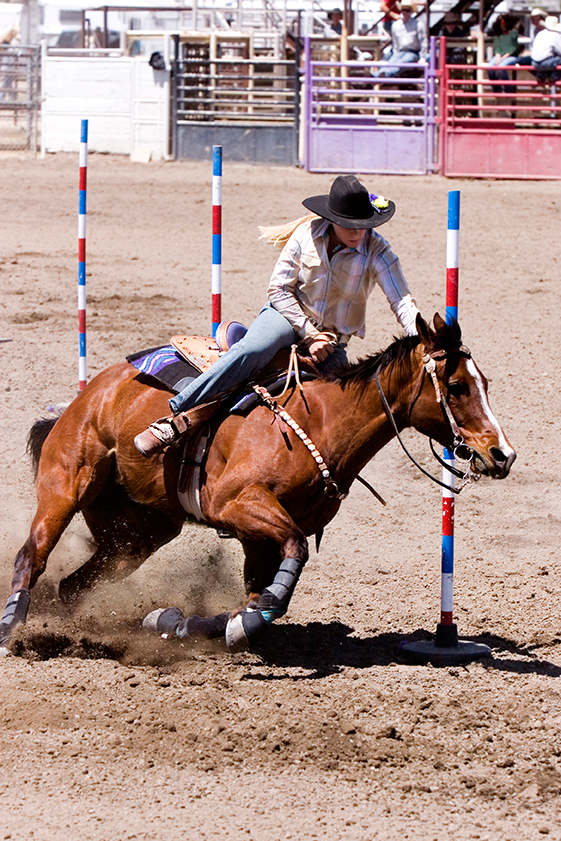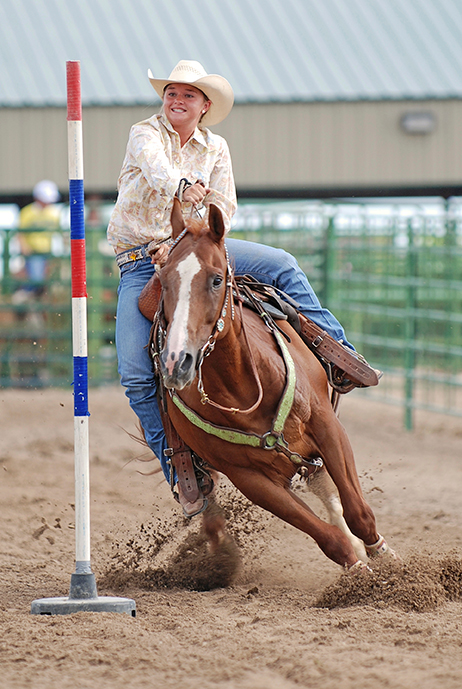
Pole bending is a timed event in equestrian sports that features a horse and one mounted rider, running a weaving or serpentine path around six poles arranged in a line. The poles are typically 21 feet (6.4 meters) apart, and the first pole is 21 feet (6.4 meters) from the starting line. The fastest horse and rider to complete the pattern without knocking over any of the poles is the winner.
Pole bending is most commonly seen at gymkhanas and rodeos, and is typically competed in by women and girls. However, there are also some men and boys who compete in pole bending at a lower level of competition.
The most common breeds of horses used in pole bending are American Quarter Horses, Paint Horses, and Appaloosas. These breeds are known for their speed, agility, and responsiveness, which are all important qualities for a successful pole bending horse.
Pole bending is a challenging but rewarding sport for both horse and rider. It requires a high level of coordination, communication, and trust between the two partners. If you are looking for a fun and exciting equestrian sport to try, pole bending is a great option.
Here are some of the benefits of pole bending:
- It is a great way to improve your horse's speed, agility, and responsiveness.
- It is a challenging but rewarding sport that can be enjoyed by people of all ages and skill levels.
- It is a great way to build a strong bond between you and your horse.
If you are interested in trying pole bending, there are many resources available to help you get started. You can find local pole bending clubs and associations, as well as online resources that offer training tips and advice. With a little practice, you'll be weaving around poles like a pro in no time!
Clubs and Associations - Pole Bending
Education - Pole Bending
Equipment - Pole Bending
Event - Pole Bending

Exercises for Horses That Are Beginning Pole Bending
by Laura College, Demand Media
Pole bending is a speed event that requires precision and stamina of both horse and rider. Practicing poles over and over again will reinforce bad habits and bore the horse, so it is important to conduct other exercises that will benefit your performance in pole bending but challenge your horse at the same time. When starting pole bending, focus on exercises that encourage responsiveness and agility.
Halt and Reverse
Practicing only speed for a speed event will yield an unresponsive horse. Your mount must learn to wait for your aids and respond to them immediately, which is why the halt and reverse is one of the best pole bending exercises. Walk, trot or lope your horse in a straight line. Sit back in the saddle and apply light pressure to the reins. If he gives his nose and lifts his shoulders in preparation for a change, reward him by releasing the pressure. If, however, he sets his jaw against the bit and lifts his head, halt him immediately. Back him up by alternating pressure on the left and right reins until he yields his nose and reverses. Then send him forward again. Repeat this exercise two or three times per training session in both directions.
Trotting the Poles
One problem frequently encountered in speed event exercises is the repetition. The horse knows how to weave the proper pattern through the poles, so he does this automatically without listening to his rider. To increase responsiveness, bring your horse to a trot on the first and last poles of your pattern, then complete the rest of the pattern at a lope. Focus on collecting your horse around those crucial poles so he lifts his shoulders and brings his hocks underneath himself. You can also try the entire pattern at an extended trot, then bring him down to a collected trot or a jog on the first and last poles.
Serpentines
Pole pending requires the horse to be flexible at all times, particularly when changing directions. During schooling, expand the pattern to the entire arena and ride several serpentines. Divide the arena into four or six loops, then trot and lope the pattern. Focus on collecting your horse on the ends of the loops and letting him extend down the center. Combine this exercise with the halt and reverse by finishing the serpentine and backing up. When conducting this exercise at a lope, remember to ask for a simple or flying change down the long side of each loop.
Lateral Flexion
Pole bending can stress your horse's joints and tendons, but exercises that increase strength and flexibility will diminish that stress. Start with simple lateral flexion. Warm up your horse at the walk, trot and lope, then bring him to a halt in the center of the arena. Using direct rein, ask your horse to bring his nose toward your right or left boot. When he gives his nose, release the rein pressure and send him forward at the walk. Repeat this exercise in the opposite direction. Once you have mastered lateral flexion, move on to other lateral exercises, such as two-track work and side passes.































